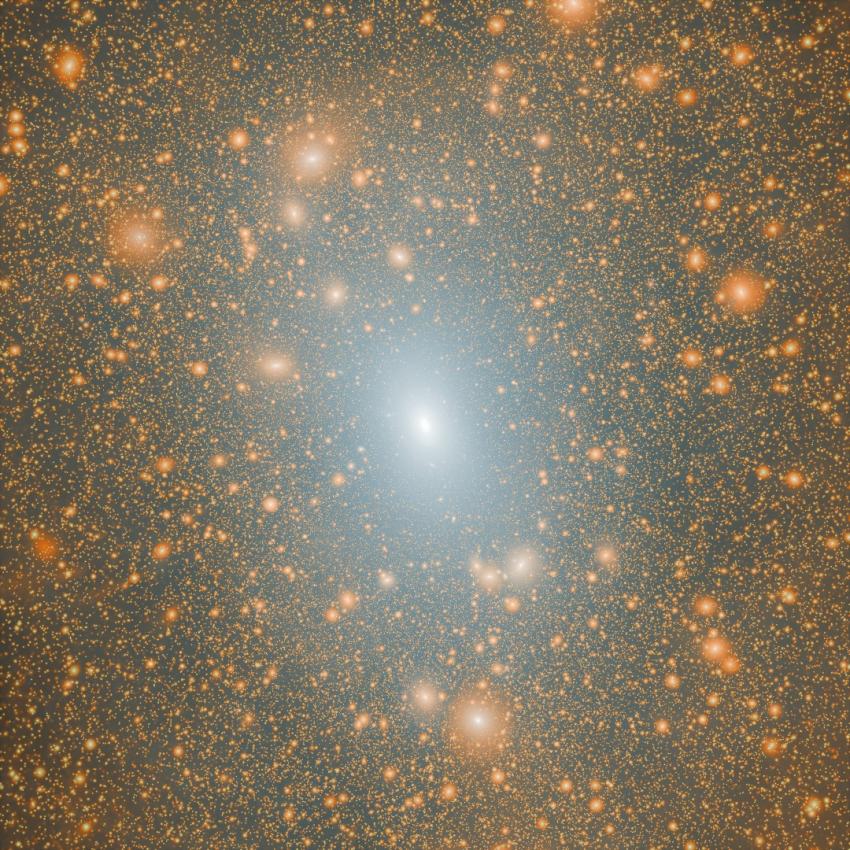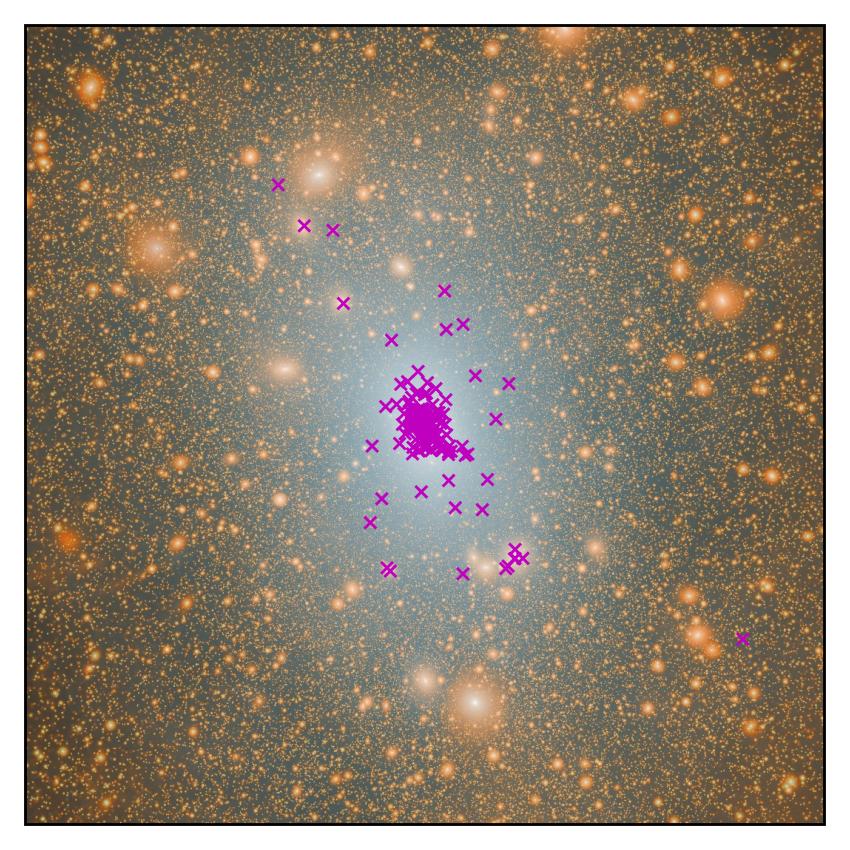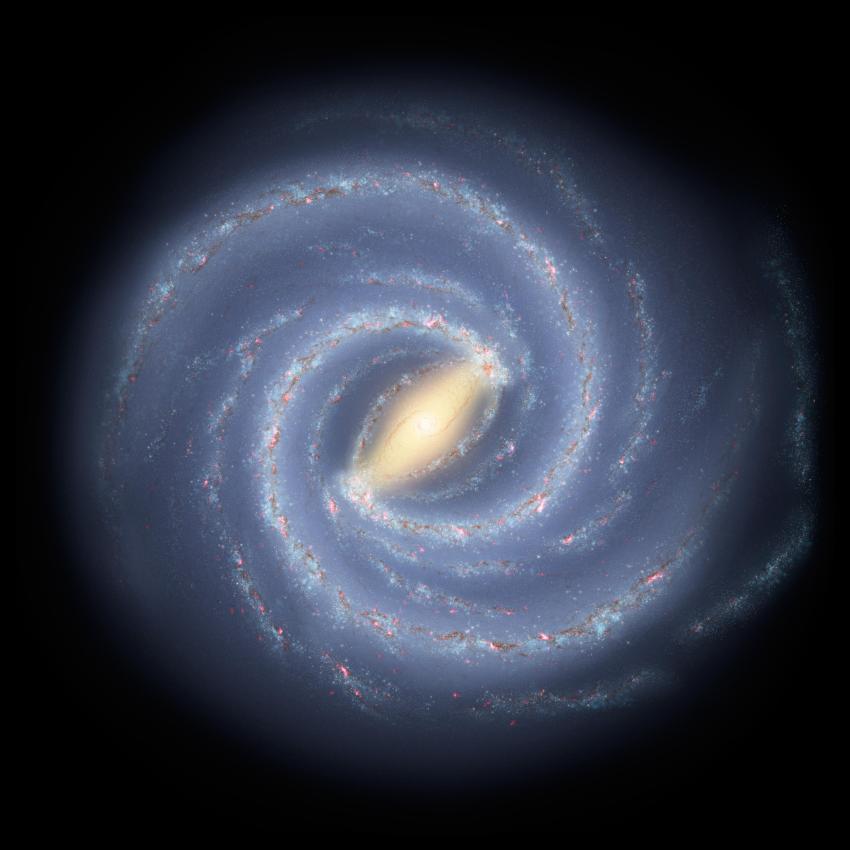The Milky Way could have many more satellite galaxies than scientists have previously been able to predict or observe, according to new research.
Cosmologists at Durham University used a new technique combining the highest-resolution supercomputer simulations that exist, alongside novel mathematical modelling, predicting the existence of missing "orphan" galaxies.
Their findings suggest that there should be 80 or perhaps up to 100 more satellite galaxies surrounding our home galaxy, orbiting at close distances.
If these galaxies are seen by telescopes then it could provide strong support for the Lambda Cold Dark Matter (LCDM) theory which explains the large-scale structure of the universe and how galaxies form.
This ongoing research is being presented today (Friday 11 July) at the Royal Astronomical Society's National Astronomy Meeting at Durham University.
The research is based on the LCDM model where ordinary matter in the form of atoms represents only 5 per cent of the universe’s total content, 25 per cent is cold dark matter (CDM), and the remaining 70 per cent is dark energy.
In this model, galaxies form in the centre of gigantic clumps of dark matter called halos. Most galaxies in the universe are low-mass dwarf galaxies, the majority of which are satellites orbiting around a more massive galaxy, such as our Milky Way.
The existence of these enigmatic objects has long posed challenges to LCDM – otherwise known as the standard model of cosmology. According to LCDM theory, many more Milky Way companion galaxies should exist than cosmological simulations have so far produced, or astronomers have been able to see.
The new research shows that the Milky Way's missing satellites are extremely faint galaxies stripped almost entirely of their parent dark matter halos by the gravity of the Milky Way’s halo. These so-called "orphan" galaxies are lost in most simulations, but should have survived in the real universe.
Using their new technique, the Durham researchers were able to track the abundance, distribution, and properties of these Milky Way orphan galaxies – showing that many more Milky Way satellites should exist and be observable today. It is hoped that new advances in telescopes and instruments like the Rubin Observatory LSST camera (which recently saw its first light), will give astronomers the ability to detect these very faint objects, bringing them into our view for the first time.
Lead researcher Dr Isabel Santos-Santos, in the Institute for Computational Cosmology, Department of Physics, Durham University, said: "We know the Milky Way has some 60 confirmed companion satellite galaxies, but we think there should be dozens more of these faint galaxies orbiting around the Milky Way at close distances.
"If our predictions are right, it adds more weight to the Lambda Cold Dark Matter theory of the formation and evolution of structure in the universe.
"Observational astronomers are using our predictions as a benchmark with which to compare the new data they are obtaining.
"One day soon we may be able to see these 'missing' galaxies, which would be hugely exciting and could tell us more about how the universe came to be as we see it today."
The concept of LCDM is the cornerstone of our understanding of the universe. It has led to the Standard Model of Cosmology and is the most widely accepted model for describing the universe's evolution and structure on large scales.
The model has passed multiple tests but has recently been challenged by puzzling observational data on dwarf galaxies.
The Durham researchers say that even the best existing cosmological simulations (which include gas and star formation, in addition to dark matter) do not have the resolution needed to study galaxies as faint as those astronomers are starting to discover close to the Milky Way.
These simulations also lack the precision required to follow the evolution of the small dark matter halos that host the dwarf galaxies as they orbit around the Milky Way over billions of years.
This leads to the artificial disruption of some halos, leaving galaxies "orphaned". Although the simulations lose the halos of "orphan" galaxies, such galaxies should survive in the real universe.
The Durham researchers combined cosmological supercomputer simulations with analytical models to overcome these numerical issues.
This included the Aquarius simulation, produced by the Virgo Consortium. Aquarius is the highest resolution simulation of a Milky Way dark matter halo ever created and is used to understand the fine-scale structure predicted around the Milky Way.
It also included the GALFORM model, a cutting-edge code developed at Durham over the past two decades which follows the detailed physical processes that are responsible for the formation and evolution of galaxies.
Their results showed that halos of dark matter, which may host a satellite galaxy, have been orbiting around the central Milky Way halo for most of the age of the universe, leading to the stripping of their dark matter and stellar mass, and rendering them extremely small and faint.
As a result, the research predicts that the total number of satellite galaxies – of any brightness – likely to exist around the Milky Way is around 80 or potentially up to 100 more than currently known.
The research puts particular emphasis on the approximately 30 newly discovered tiny Milky Way satellite candidates that are extremely faint and small.
Scientists are unclear if these are dwarf galaxies embedded in a dark matter halo, or globular clusters, collections of self-gravitating stars.
The Durham researchers argue that these objects could be a subset of the faint population of satellite galaxies they predict should exist.
Co-researcher Professor Carlos Frenk, of the Institute for Computational Cosmology, Department of Physics, Durham University said: "If the population of very faint satellites that we are predicting is discovered with new data, it would be a remarkable success of the LCDM theory of galaxy formation.
"It would also provide a clear illustration of the power of physics and mathematics. Using the laws of physics, solved using a large supercomputer, and mathematical modelling we can make precise predictions that astronomers, equipped with new, powerful telescopes, can test. It doesn't get much better than this."
The research is funded by the European Research Council through an Advanced Investigator grant to Professor Frenk, and by the Science and Technology Facilities Council (STFC).
The calculations were performed on the Cosmology Machine (COSMA), a supercomputer supported by the STFC's Distributed Infrastructure for Research using Advanced Computing (DiRAC) project, and hosted by Durham University.
ENDS
Media contacts
Sam Tonkin
Royal Astronomical Society
Mob: +44 (0)7802 877 700
Dr Robert Massey
Royal Astronomical Society
Mob: +44 (0)7802 877 699
Megan Eaves
Royal Astronomical Society
Science contacts
Dr Isabel Santos
Durham University
Images & captions
Caption: The dark matter distribution of a Milky Way mass halo in a Lambda-cold dark matter (LCDM) cosmological simulation. This is the highest resolution simulation of a MW-mass dark matter halo ever performed, called Aquarius-A-L1. The MW halo (in the centre) is surrounded by myriad substructures, a key prediction of the "cold dark matter” model. Some of these subhalos host a satellite galaxy within them that could be observable.
Credit: The Aquarius simulation, the Virgo Consortium/Dr Mark Lovell
Caption: The dark matter distribution of a Milky Way mass halo in a Lambda-cold dark matter (LCDM) cosmological simulation. This is the highest resolution simulation of a MW-mass dark matter halo ever performed, called Aquarius-A-L1. The MW halo (in the centre) is surrounded by myriad substructures, a key prediction of the "cold dark matter” model. Some of these subhalos host a satellite galaxy within them that could be observable. The new predicted Milky Way “orphan satellite” galaxies are marked with an 'x' symbol.
Credit: The Aquarius simulation, the Virgo Consortium/Dr Mark Lovell
Caption: An artist’s concept of the Milky Way galaxy.
Credit: NASA/JPL-Caltech
Further information
The talk ‘The contribution of "orphan" galaxies to the ultrafaint population of MW satellites’ will take place at NAM at 10:15 BST on Friday 11 July 2025 in room TLC106. Find out more at: https://conference.astro.dur.ac.uk/event/7/contributions/515/
Notes for editors
The NAM 2025 conference is principally sponsored by the Royal Astronomical Society and Durham University.
About the Royal Astronomical Society
The Royal Astronomical Society (RAS), founded in 1820, encourages and promotes the study of astronomy, solar-system science, geophysics and closely related branches of science.
The RAS organises scientific meetings, publishes international research and review journals, recognises outstanding achievements by the award of medals and prizes, maintains an extensive library, supports education through grants and outreach activities and represents UK astronomy nationally and internationally. Its more than 4,000 members (Fellows), a third based overseas, include scientific researchers in universities, observatories and laboratories as well as historians of astronomy and others.
The RAS accepts papers for its journals based on the principle of peer review, in which fellow experts on the editorial boards accept the paper as worth considering. The Society issues press releases based on a similar principle, but the organisations and scientists concerned have overall responsibility for their content.
Keep up with the RAS on Instagram, Bluesky, LinkedIn, Facebook and YouTube.
Download the RAS Supermassive podcast
About the Science and Technology Facilities Council
The Science and Technology Facilities Council (STFC), part of UK Research and Innovation (UKRI), is the UK’s largest public funder of research into astronomy and astrophysics, particle and nuclear physics, and space science. We operate five national laboratories across the UK which, supported by a network of additional research facilities, increase our understanding of the world around us and develop innovative technologies in response to pressing scientific and societal issues. We also facilitate UK involvement in a number of international research activities including the ELT, CERN, the James Webb Space Telescope and the Square Kilometre Array Observatory.
About Durham University
Durham University is a globally outstanding centre of teaching and research based in historic Durham City in the UK.
We are a collegiate university committed to inspiring our people to do outstanding things at Durham and in the world.
We conduct research that improves lives globally and we are ranked as a world top 100 university with an international reputation in research and education (QS World University Rankings 2026).
We are a member of the Russell Group of leading research-intensive UK universities and we are consistently ranked as a top five university in national league tables (Times and Sunday Times Good University Guide and The Complete University Guide).
For more information about Durham University visit: www.durham.ac.uk/about/




